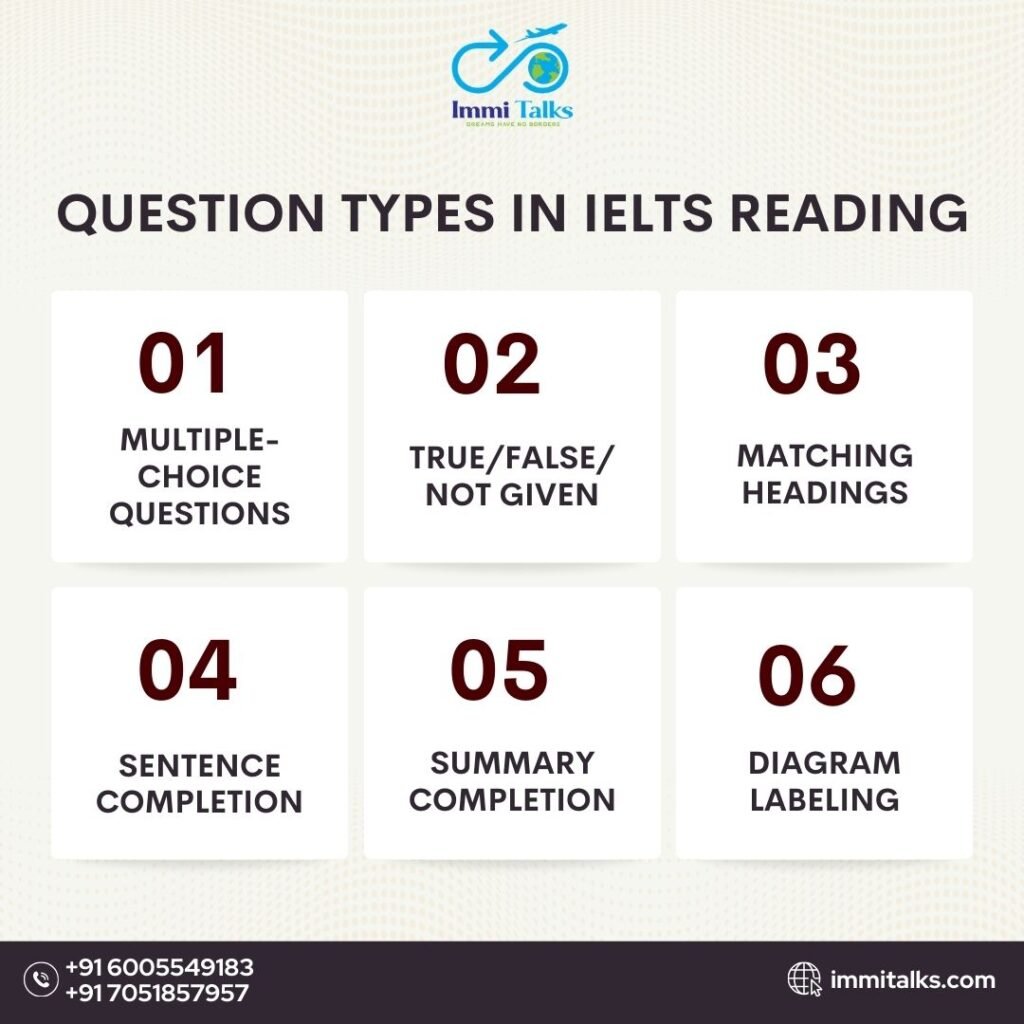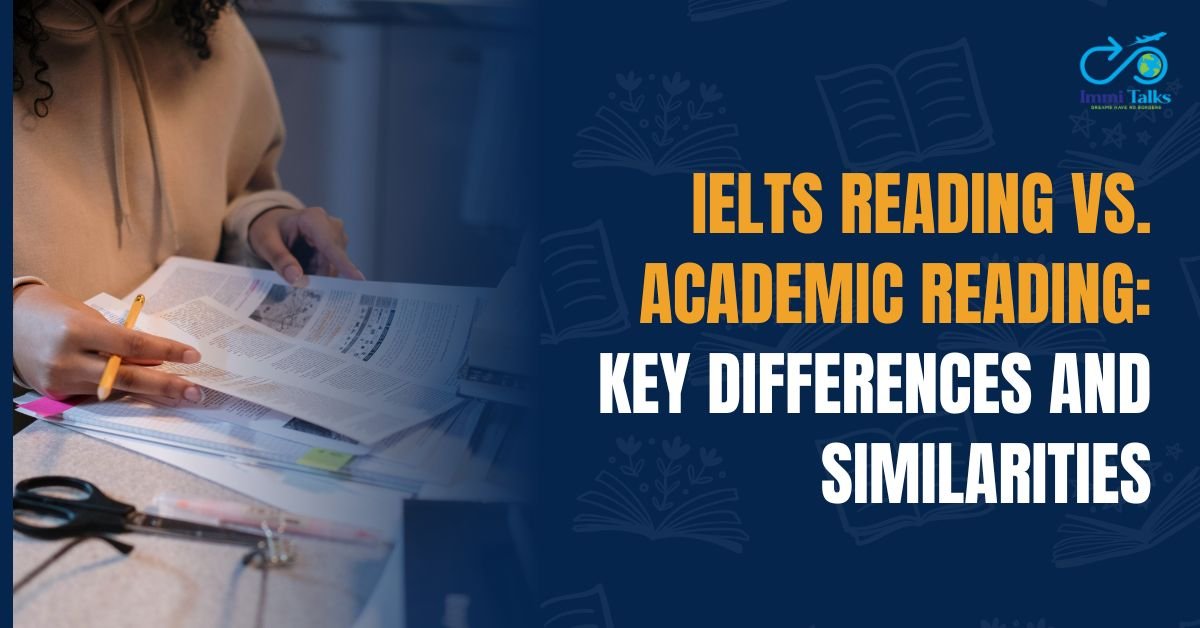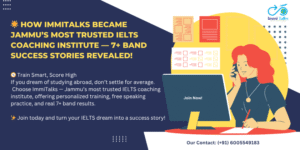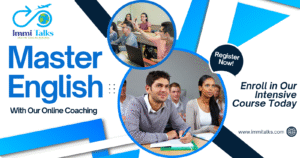For students preparing for the IELTS Reading test, understanding how it differs from general academic reading is crucial. While both require strong comprehension skills, they have distinct purposes, structures, and challenges. This article will explore the key differences and similarities between IELTS and academic reading, helping test-takers develop an effective strategy for success.
Understanding IELTS Reading
The test assesses a candidate’s ability to understand and analyze written information. It consists of 40 questions and lasts for 60 minutes. The reading section varies depending on the test type:
- IELTS Academic Reading – For those applying to universities or professional institutions. It includes three long, complex passages from books, journals, and newspapers.
- IELTS General Training Reading – For those moving abroad for work or migration. It includes shorter, everyday texts like advertisements, notices, and work-related documents.
Question Types in IELTS Reading

The test includes various question types:
- Multiple-choice questions
- True/False/Not Given
- Matching headings
- Sentence completion
- Summary completion
- Diagram labeling
These formats test a range of skills, such as skimming, scanning, inference, and critical thinking—essential for understanding written content effectively.
Understanding Academic Reading
Academic reading is an essential skill for students pursuing higher education. Unlike IELTS Reading, which is a standardized test, academic reading involves understanding research papers, textbooks, and scholarly articles. It requires:
- In-depth analysis – Understanding theories, arguments, and research findings.
- Note-taking – Summarizing key points for future reference.
- Critical evaluation – Comparing different viewpoints and forming independent conclusions.
Academic reading is not timed, allowing students to process information at their own pace, unlike the IELTS test, where time management is crucial.
Key Differences Between IELTS Reading and Academic Reading
| Feature | IELTS Reading | Academic Reading |
| Purpose | Tests reading skills for English proficiency | Helps understand complex subjects in depth |
| Text Type | Magazines, newspapers, advertisements, academic articles | Research papers, textbooks, journal articles |
| Time Constraint | 60 minutes for both section | 60 minutes for both section |
| Question Types | Multiple-choice, matching, True/False/Not Given | No fixed format – open-ended understanding |
| Skills Required | Skimming, scanning, and quick comprehension | Deep analysis, summarization, and critique |
While IELTS Reading emphasizes efficiency and accuracy under pressure, academic reading emphasizes depth and comprehension for long-term learning.
Key Similarities Between IELTS Reading and Academic Reading
Despite their differences, both share some common aspects:
- Comprehension Skills – Both require an understanding of main ideas, supporting details, and logical flow.
- Vocabulary Development – A strong grasp of vocabulary helps improve reading proficiency in both contexts.
- Inference and Analysis – Whether answering IELTS questions or analyzing academic texts, readers must infer meanings and identify underlying arguments.
By improving these skills, IELTS test-takers can also enhance their academic reading abilities, making university coursework easier.
How ImmiTalks Can Help You Ace IELTS Reading
Preparing for this test can be challenging, especially for non-native English speakers. ImmiTalks offers comprehensive materials, designed to:
- Improve comprehension skills with real IELTS-like passages.
- Enhance time management through practice tests.
- Familiarize test-takers with different question types and answer strategies.
- Provide expert tips and strategies to boost confidence.
With ImmiTalks’ IELTS Reading Material, students can gain practical experience and develop effective reading techniques to maximize their scores.
Final Thoughts
While IELTS Reading and academic reading share similarities in comprehension and analysis, they serve different purposes. IELTS Reading is a timed test focusing on quick interpretation and efficiency, while academic reading emphasizes in-depth understanding and critical evaluation.
To perform well, candidates should practice with structured materials, develop strong skimming and scanning skills, and manage their time effectively. ImmiTalks’ expertly designed resources can help test-takers build confidence and achieve their desired score. If you’re preparing for IELTS and need high-quality reading materials, check out ImmiTalks’ study resources for the best preparation!






At this page you can find a lot of useful information.
It is made to support you with multiple topics.
You will find clear explanations and everyday examples.
The content is regularly updated to stay current.
https://findradio.us
It’s a great resource for learning.
All users can take advantage of the materials here.
Feel free to checking out the site today.
This site offers a lot of captivating and helpful content.
On this site, you can find a wide range of sections that cover many relevant themes.
Every post is written with focus to detail.
The content is constantly refreshed to keep it relevant.
Visitors can get something new every time they come here.
It’s a wonderful place for those who are interested in thoughtful reading.
Many people find this website to be well-organized.
If you’re looking for quality content, you’ll surely discover it here.
Creative photography often focuses on highlighting the beauty of the natural shape.
It is about light rather than surface.
Professional photographers use natural tones to convey atmosphere.
Such images celebrate delicacy and personality.
https://xnudes.ai/
Every frame aims to evoke feelings through form.
The purpose is to present inner grace in an artful way.
Audiences often value such work for its emotional power.
This style of photography combines technique and aesthetics into something truly timeless.
Современные поисковые системы для анализа данных становятся всё более востребованными.
Они дают возможность изучать открытые данные из интернета.
Такие инструменты используются для исследований.
Они умеют точно обрабатывать большие объёмы информации.
eye god tg
Это помогает создать более объективную картину событий.
Отдельные системы также обладают удобные отчёты.
Такие боты популярны среди исследователей.
Развитие технологий позволяет сделать поиск информации доступным и удобным.
Maintaining control while gaming is essential for ensuring a healthy gaming experience.
It helps participants benefit from the activity without harmful effects.
Being aware of your boundaries is a key part of mindful gaming.
Players should establish reasonable budget limits before they start playing.
Casino Deals AU
Short pauses can help maintain focus and stay relaxed.
Transparency about one’s habits is important for keeping gaming a fun activity.
Many services now support responsible gaming through helpful guidelines.
By keeping balance, every player can enjoy gaming while preserving their balance.
Дизельное топливо — это ключевой энергоресурс, который широко используется в различных сферах.
Благодаря своей плотности энергии дизельное топливо позволяет достичь стабильную работу оборудования.
Надёжное топливо улучшает эффективность работы двигателя.
Существенное влияние имеет чистота топлива, ведь примеси могут снизить эффективность.
Производители дизельного топлива стараются выполнять все стандарты.
Инновационные подходы позволяют улучшать показатели топлива.
Перед приобретением дизельного топлива важно учитывать сертификаты качества.
Хранение и транспортировка топлива также влияют на его качество.
Плохое топливо может вызвать увеличению расхода.
Поэтому контроль качества продукта — необходимое условие.
Сегодня представлено широкий выбор дизельного топлива, отличающихся по составу.
Морозостойкие виды дизельного топлива гарантируют функционирование оборудования даже при экстремальных условиях.
Благодаря развитию современных подходов качество топлива улучшается.
Ответственный подход в вопросе использования дизельного топлива помогают стабильную работу техники.
Таким образом, правильно подобранное ДТ является фундаментом устойчивого функционирования любого оборудования.
Английский язык сегодня считается незаменимым умением для жителя современного мира.
Он помогает общаться с жителями разных стран.
Без владения языком почти невозможно развиваться профессионально.
Работодатели требуют сотрудников, владеющих английским.
курсы toefl
Регулярная практика английского делает человека увереннее.
С помощью английского, можно учиться за границей без ограничений.
Кроме того, регулярная практика повышает концентрацию.
Таким образом, знание английского языка играет важную роль в саморазвитии каждого человека.
Оформление второго гражданства за границей становится всё более актуальным среди россиян.
Такой статус предоставляет дополнительные перспективы для путешествий.
Гражданство другой страны помогает легче пересекать границы и получать доступ к другим странам.
Помимо этого такой документ может повысить финансовую стабильность.
Паспорт Сент Люсии
Все больше людей рассматривают возможность переезда как способ расширения возможностей.
Имея ВНЖ или второй паспорт, человек легко открыть бизнес за рубежом.
Многие государства предлагают свои программы получения гражданства.
Поэтому вопрос оформления становится всё более значимой для тех, кто планирует развитие.
Casino Roulette: Spin for the Ultimate Thrill
Experience the timeless excitement of Casino Roulette, where every spin brings a chance to win big and feel the rush of luck. Try your hand at the wheel today at https://k8o.jp/ !
Современная система очистки играет ключевую роль в бытовых условиях.
Такая система помогает нейтрализовать опасные примеси из воды.
При качественной фильтрации, тем чище становится домашняя вода.
Многие семьи оценивают необходимость использования эффективных водоочистителей.
Новые фильтрационные решения позволяют добиться стабильного результата.
https://domikarkas.ru/raznoe/filtry-mehanicheskoj-ochistki-vody-vidy-i-printsip-dejstviya.html
Хорошо настроенная фильтрация помогает предотвратить негативные воздействия для всей семьи.
Регулярная замена фильтров повышает эффективность водоочистной системы.
Следовательно, качественная система очистки воды — это важный элемент для здоровой жизни.
Здесь представлено большое количество полезного контента.
Пользователи отмечают, что ресурс облегчает доступ к важным данным.
Информация поддерживается в актуальном состоянии, что делает сайт практичным для использования.
Многие считают, что структура сайта интуитивно ясна и позволяет сэкономить время.
Большое разнообразие тем делает ресурс интересным для широкой аудитории.
Также отмечается, что материалы написаны профессионально и читаются без труда.
Сайт помогает углублять понимание различных тем благодаря детальным обзорам.
Таким образом, этот ресурс можно назвать удобным местом для изучения важных тем для всех пользователей.
https://dpnews.ru